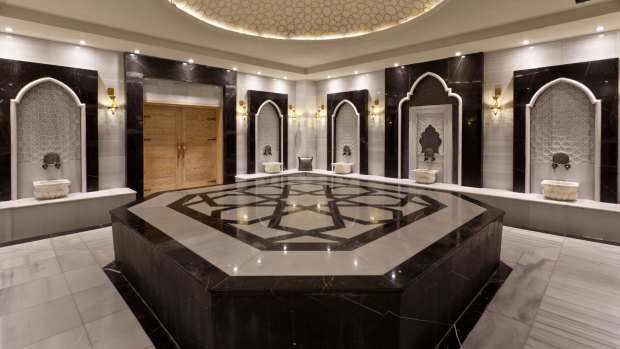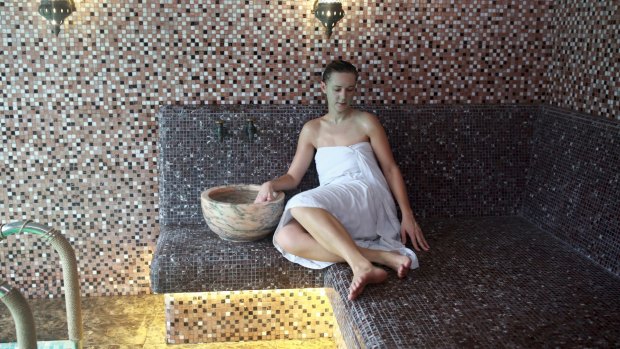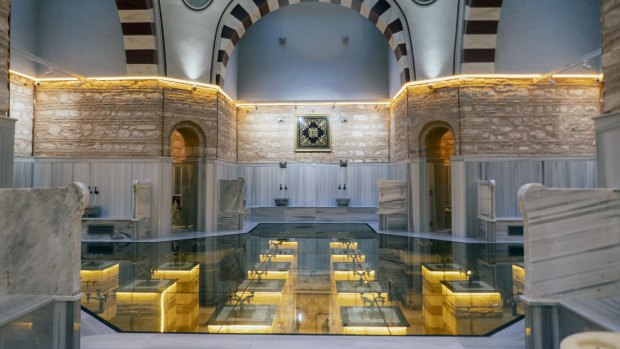This was published 1 year ago
Guide to doing a hammam in Turkey: Lesson one - leave your undies on

Hammam's are not like Roman baths, mainly because there are no actual baths. Credit: iStock
It's late summer, late on a sultry afternoon, when eight of us on an all-woman trip across Turkey arrive in the seaside city of Antalya after a long drive. This Turquoise Coast is spectacular, all Mediterranean cliffs towering over small perfect beaches freckled by dozens of sun umbrellas. I can't wait to wriggle my toes in the sand.
Our guide, Nilufer, has other ideas. We're booked into a hammam for the afternoon, she says. I've long been a fan of Japanese onsen, but this doesn't seem the place, or the season, for a hot bath. Shouldn't we be cooling off in the sea?
I soon learn that Antalya is one of the most perfect spots in the whole of Turkey for a hammam – because it's in Anatolia, birthplace of the Ottoman Empire, which popularised them. Public bathing has been around for eons of course, but "Turkish baths" were born when the Turkic people of Central Asia merged their steam baths, called "manchu", with the Roman bath culture they found on arriving in Anatolia in the 11th century. When the Ottomans subsequently built hammams (from the Arabic word "hamma" meaning "heating up") throughout their vast empire between the 14th and early 20th centuries, Anatolia became hammam-central.

Although the popularity of hammams in Turkey declined with the advent of private bathrooms, they've been experiencing a resurgence recently as spa-like retreats,Credit: iStock
They were originally just for men, although the harems of sultans and other nobles often had their own women-only hammams. Then women who were ill or recovering from childbirth were allowed to go and before long all Ottoman women had access to public hammams, which were often free because they were believed to keep diseases away.
"Even slaves went to the hammam, to prevent epidemics," says Nilufer.
Visiting a hammam had social benefits too, particularly for women. They were places to escape the isolation of home life, to celebrate an impending wedding or a new baby with other women. There were "holiday baths" on the eve of religious festivals and "tear-drying baths" after a death. And although the popularity of hammams declined with the advent of private bathrooms, they've been experiencing a resurgence recently as spa-like retreats, particularly in Antalya.

You pass through a hammam's three interconnected rooms in sequence. Credit: iStock
STEP ONE: GET NEARLY NAKED
There are still men-only hammams with dedicated women-only times of day, but the hammam we're visiting, Demirhan Hamam (there's only one "m" in the Turkish word) in central Antalya, has separate men's and women's facilities and two entrances. As we file in, we pass a sign above the women's doorway. "Men forbidden," it says, in Turkish.
Nilufer isn't joining us for this experience, so we're on our own - which is how we make our first foreigner faux pas: not keeping our undies on. Assuming this would be like an onsen experience, we all disrobe completely in the change rooms and emerge, obliviously starkers, locker keys dangling from elastic cords around our wrists, clutching the much-too-small "peshtemal" towels provided.
But hammams are nothing like Japanese onsen; there is no serene soaking here. Nor are they like Roman baths, mainly because there are no actual baths. Instead the water is kept flowing, in accordance with Islamic custom, and the idea is that you pass through the hammam's three interconnected rooms, in sequence. First you sweat away your cares and the skin-deep detritus of daily life in the hot room, "sicaklik" in Turkish. Then you wash in the warm room, the "iliklik". Finally there's a cool room, a "sogukluk", for rest, relaxation and refreshments.
SWEAT, SCRUB, WASH
We're only a few days into this group trip, so it feels odd to find ourselves sprawled next to each other on a circular marble slab in a circular tiled room, like spokes in a human bicycle wheel. There are nervous giggles as we lie on our backs, admiring the impressive domed ceiling. It's hot and steamy, a sexless orgy of flesh and pink towels. An attendant, suddenly noticing our collective, forbidden, nudity, rushes out to fetch more towels to drape over our lady parts.
When my head starts to throb from the heat, I sit up and splash cold water on my face from one of the taps at the side of the room – and see two Turkish women, wearing undies, washing themselves (the self-serve option) and clearly amused by the sight of eight naked Australian, British and German women in their local bathhouse.
After what seems like a sweaty eternity, two sturdy female attendants wearing large black bras and briefs arrive to scrub us all vigorously with soapy mitts, one by one, while we lie face down, then face up, then perched on the edge of the slab. Alarmingly, I seem to shed a lot of dead skin.
Next, I'm led by the hand into the warm room and told to lie on a marble bench against one wall. Another attendant flops a soapy pillowcase onto my back and rubs it all over me to make suds. I feel like a small child being washed by an aunty I've never met. So skillful are these women that even when they sit you up to wash your hair – again, I feel about four years old – no soap gets in my eyes. I stand up and my attendant sloshes me with several buckets of warm water, which makes me giggle again, then she swaddles me in a large fluffy towel before ushering me into the adjoining cool room.
THE COOL-DOWN
I join my freshly washed comrades resting on vinyl recliners. Bottles of water and glasses of sweet apple tea materialise beside us. Then a woman carrying a jar of paint and an artist's brush begins to liberally apply green clay to our upturned faces.
Here's the scene: eight of us, our faces caked in green, lying in two facing rows of red armchairs, dressed only in bright orange towels. Yesterday, we were still learning each other's names. Today we're bonded by nakedness and a shared surrender to this unfamiliar experience. Suddenly one of the attendants turns on a stereo and cranks up the volume and before we know it we're all up and dancing around the room to the beat of loud Turkish pop music, linking pinkies, holding up our towels, smiles creasing our green faces.
"There's something to be said for not having any men around," laughs Carol from Texas.
Impromptu party over, our faces rinsed clean, there's one final step: a 20-minute communal massage. In a glass-walled room, five massage therapists drizzle olive oil onto five of us at a time as we lie on whisper-close massage tables. It's like a turkey-basting production line, with a soundtrack of slapping and pummelling.
Two hours after we'd first stepped into this place as hammam virgins, we emerge - fully clothed, feeling silky smooth all over, laughing and chatting as if we've known each other all our lives. The sun has set and the day has cooled, but inside I feel the warmth of a sisterhood without borders. This is what hammams are all about, I've learned: a scrubbing away of differences until all that remains is the sudden clarity that, for a couple of hours at least, we're all equal underneath.
THE DETAILS
FLY
Qantas flies from Sydney, Melbourne, Brisbane and Perth to Istanbul via Dubai, codesharing with Emirates. See qantas.com
BATHE
Demirhan Hamam is open 9am to 11pm daily and the full scrub-wash-massage-facial experience costs $US35 ($52) a person. See antalyademirhanhamam.com
STAY
Tuvana Hotel, an historic boutique hotel in Antalya's Old Town, has four restaurants, a swimming pool and rooms from €75 ($120) a night. See tuvanahotel.com
MORE
Antalya was unaffected by the February earthquakes that devastated parts of south-eastern Turkey.
Louise Southerden travelled as a guest of Intrepid Travel intrepidtravel.com
Sign up for the Traveller Deals newsletter
Get exclusive travel deals delivered straight to your inbox. Sign up now.